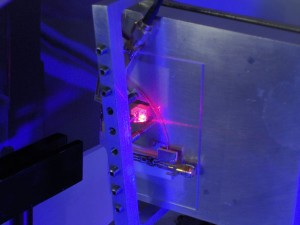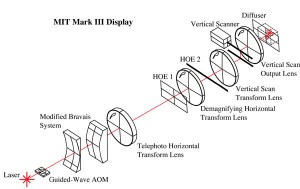Guided-wave Devices for Holographic Video Display
We are developing a guided-wave optical modulator [1] [2] with 1-GHz composite bandwidth Surface Acoustic Wave (SAW) transducer arrays for use in video displays. This device is designed to diffract light horizontally and deflect it vertically through mode conversion by creating surface acoustic waves that interact with light trapped in waveguides on the surface of a lithium niobate substrate. To fabricate this modulator, we first mask a wafer of Z-cut lithium niobate with SiO2 through a plasma-enhanced chemical-vapor-deposition (PECVD) process and then immerse it in heated benzoic acid and lithium benzoate to create single polarization waveguides. The waveguide is subsequently annealed to restore its acoustic properties. Finally, we pattern aluminum transducers onto the waveguides by conformal contact lithography employing a negative resist lift-off technique.
The goal of this work is to enable the inexpensive manufacturing of Scophony-architecture video displays [3] (both 2D and holographic video [4] [5] [6] [7]) without the need for the horizontal scanning mirrors that typically limit the scalability of this technology.
Our current research effort seeks to characterize the TM (transverse magnetic) guided to TE (transverse electric) leaky mode coupling in proton-exchanged lithium niobate waveguides for use in integrated display technologies. Several types of proton-exchanged waveguides are being tested including TIPE (Titanium Indiffused Proton Exchange), DPE (Dilute Proton Exchange), and RPE (Reverse Proton Exchange). The waveguide technology with the most optimal mode coupling performance will be used as a platform for integrated diffractive projectors and spatial light modulators for holographic video displays.
References
- C.S. Tsai, Q. Li, and C.L. Chang, “Guided-wave two-dimensional acousto-optic scanner using proton-exchanged lithium niobate waveguide,” Fiber and Integrated Optics, vol. 17, pp. 57-166, 1998. [↩]
- D. Smalley, “Integrated-optic holovideo,” Master’s thesis, Massachusetts Institute of Technology, Cambridge MA, 2006. [↩]
- H.W. Lee, “The Scophony television receiver,” Nature, vol. 142, pp. 59-62, July 1938 [↩]
- D.E. Smalley, Q.Y.J. Smithwick, and V.M. Bove, Jr., “Holographic video display based on guided-wave acousto-optic devices,” Proc. SPIE Practical Holography XXI, vol. 6488, p. 64880L, 2007. [↩]
- Q.Y.J. Smithwick, D.E. Smalley, V.M. Bove, Jr., and J. Barabas, “Progress in holographic video displays based on guided-wave acousto-optic devices,” Proc. SPIE Practical Holography XXII, v. 6912, p. 69120H, 2008. [↩]
- Q.Y.J. Smithwick, J. Barabas, D.E. Smalley, and V.M. Bove, Jr., “Real-time shader rendering of holographic stereograms,” Proc. SPIE Practical Holography XXIII, v. 7233, p. 723302, 2009. [↩]
- W. Plesniak, M. Halle, V.M. Bove, Jr., J. Barabas, and R. Pappu, “Reconfigurable image projection (RIP) holograms,” Optical Engineering, vol. 45, p. 115801, Nov. 2006. [↩]

